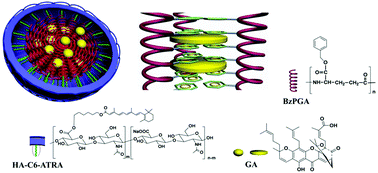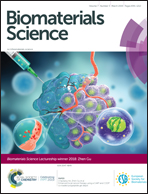Improved druggability of gambogic acid using core–shell nanoparticles†
Abstract
Gambogic acid (GA) is a natural antitumor drug candidate with advantages of broad-spectrum activity, low toxicity and multiple mechanisms. Its clinical application is hindered, however, by low aqueous solubility, instability and poor pharmacokinetic properties. In this research, core–shell hybrid nanoparticles have been developed to improve the druggability of GA. The nanoparticles are composed of a benzylamidated poly(γ-glutamic acid) (BzPGA) derivative as a core material and an amphiphilic hyaluronic acid derivative grafted with all-trans retinoic acid (HA-C6-ATRA) as a shell material. Through π–π stacking interactions, GA is encapsulated into BzPGA to form the “core” of the hybrid nanoparticle and the “shell” is formed by HA-C6-ATRA with a π–π stacking mediated “molecular fence”. The nanovehicle, with sub 100 nm size, provides almost 100% encapsulation efficiency, a good protective effect and a sustained release profile for GA. A series of evaluations suggest that the core–shell nanoparticles provide a stable aqueous injection formulation (I), improved stability (II), prolonged circulation time and conferred tumor targeting properties (III) for GA. As a result, the anti-tumor activity of GA is significantly enhanced without causing higher toxicity, indicating that the designed nanoplatform dramatically improves the druggability of GA. This study may also provide inspiration for drug development research.



 Please wait while we load your content...
Please wait while we load your content...